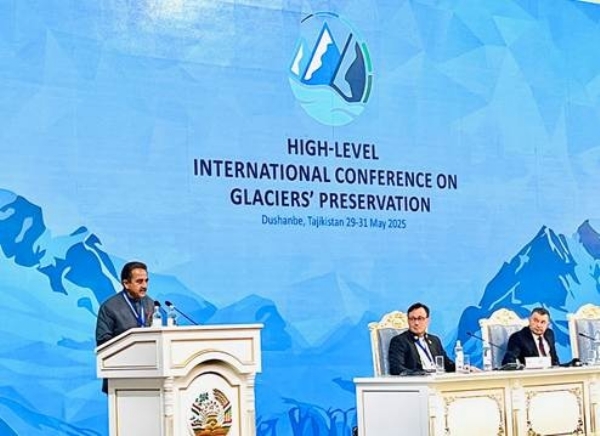
Delhi, 31 May (H.S.): Union Minister of State for Environment, Forest and Climate Change Kirti Vardhan Singh addressed the High-Level International Conference on Glaciers’ Preservation from 29th to 31st May 2025 in Dushanbe, Tajikistan. The conference gathered international experts and policymakers to discuss urgent actions for glacier protection, vital freshwater sources and indicators of climate change. Kirti Vardhan Singh underscored that glacier retreat signifies not just a warning but an immediate reality impacting water security, biodiversity, and billions of people’s livelihoods, particularly affecting mountain regions like the Himalayas. He expressed India’s concern, given its connection to the Himalayan ecosystem, and mentioned ongoing initiatives for glacial monitoring and climate adaptation.
India's strategic actions include the National Mission for Sustaining the Himalayan Ecosystem (NMSHE), part of its National Action Plan on Climate Change (NAPCC), and the establishment of a Centre for Cryosphere and Climate Change Studies to enhance glacier research and monitoring in the Indian Himalayan Region. Additionally, Singh highlighted the use of advanced Remote Sensing and GIS technologies by the Indian Space Research Organisation (ISRO) to monitor glacier mass, extent, and dynamics. These efforts are bolstered by collaborative research from institutions such as the National Centre for Polar and Ocean Research (NCPOR), National Institute of Hydrology (NIH), and Wadia Institute of Himalayan Geology. Such initiatives are essential for advancing scientific comprehension of glacier systems and facilitating data-driven policy for the sustainable management of India’s water resources.
India has enhanced disaster preparedness in the Himalayan region through better early warning systems and GLOF risk mapping, led by the NDMA. The importance of regional cooperation was highlighted to strengthen resilience, improve data-sharing frameworks, and foster coordinated responses to mountain ecosystem challenges. The Minister reiterated India’s commitment to equity and the CBDR–RC principle in global climate action, noting South Asia's minimal contribution to emissions while being significantly vulnerable to climate change. Under Prime Minister Narendra Modi's leadership, India pursues an ambitious climate strategy, making notable strides in meeting its NDCs from the Paris Agreement, including achieving over 48% of installed electricity capacity from non-fossil fuels, a 36% reduction in GDP emission intensity from 2005 to 2020, and creating a carbon sink of 2.29 billion tonnes CO₂ equivalent through enhanced forest cover between 2005 and 2021. The need for differentiated, context-specific climate adaptation and mitigation strategies, considering national circumstances and responsibilities, was emphasized. The Minister also welcomed the declaration of 2025 as the International Year of Glaciers’ Preservation and the Decade for Cryospheric Sciences (2025–2034), urging for heightened global cooperation, shared research, and increased support for developing countries. India is prepared to strengthen partnerships, share expertise, and contribute to efforts aimed at protecting glaciers and ensuring resilience for the future.
---------------
Hindusthan Samachar / Jun Sarkar








